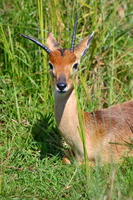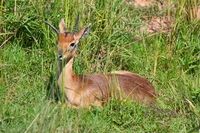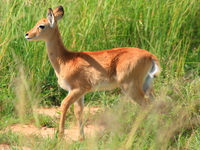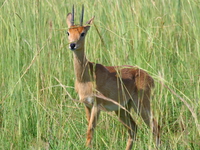oribi of uganda
Oribi are found in most countries throughout sub-Saharan Africa. Ranging from Senegal to west and central Ethiopia and southern Somalia, southward into eastern Kenya, across into north Botswana, Uganda, and Angola, with patchy and discontinuous distribution through Mozambique, Zimbabwe and into central and eastern South Africa.
The back and upper chest of an oribi is yellow to orange-brown. The chin, throat, chest, belly and rump are white. The tail is short and bushy, the upper side black or dark brown, and the under surface white. The white crescent-shaped band of fur above the eye is a characteristic that helps to distinguish this species from other similar-looking antelope. Below each ear is a large round black glandular patch, the nostrils are prominently red, and on the sides of the face are vertical creases that house the pre-orbital glands. These glands produce an odorous secretion that is used to mark the oribi's territory. Only males grow horns, which are slender and upright, ridged to about halfway up, the ends being smooth and pointed, with some of length 19 cm (7.5 inches) being recorded.
Oribi fall prey to numerous animals including lions, leopards, caracals, hyenas, hunting dogs, jackals, crocodiles and pythons. Young are also taken by eagles, genets and other small carnivores.
Oribi are graceful slender-legged, long-necked small antelope found in grassland almost throughout Sub-Saharan Africa. They grow to around 92�110 cm (36 to 43 inches) in length, with a shoulder height of 50�66 cm (20 to 26 inches) and weigh an average of 12�22 kg (26 to 49 lb). They can run at speeds of up to 40�50 km/h (25�31 mph). In captivity they have a lifespan of up to 14 years.




